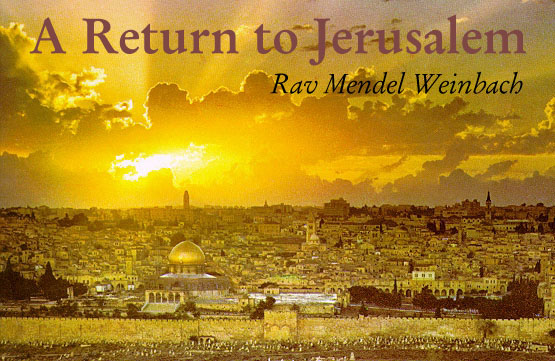A Return to Jerusalem

"I rejoiced when they said to me -
let us go to the House of Hashem."
We sang these words of King David, the Sweet Singer of Israel,
as we walked to the Kotel in the wee hours of the morning many years
ago. It was Shavuot Night, and countless thousands of Jews had
been up all night studying Torah to make up for the shortcoming
of their ancestors over 3,000 years earlier in sleeping the night before
they received the Torah at Sinai.
Now those Jews were pouring out of all the streets onto the main thoroughfare leading to the Old City, forming a human sea brimming with song and ecstasy. For most of them this would be their first encounter with the Kotel. Many of them had not even been born when that last remnant of the site where once stood the House of Hashem fell into Jordanian captivity in the War of Independence in 1948. Others, like myself, had arrived in Israel only a few years before it was liberated by Israeli soldiers.
The Kotel had been in Israeli control for a week already, but the military authorities wanted to ascertain that there were not mines or snipers lurking on the way to the Old City before giving the public access to the Kotel. Some intrepid individuals had somehow infiltrated and brought back dramatic accounts of their inspirational experience. But the general public waited for the green light of the army, and it finally came on Shavuot.
Shavuot and the Kotel
What a combination!
It was an updated version of the historic link between Torah and Jerusalem expressed
in the passage said and sung by Jews for generations when the
Torah is taken out of its ark: "For from Zion shall come
forth Torah and the Word of Hashem from Jerusalem."
Zion was the site of the Beit Hamikdash with its celestial corps of kohanim steeped in Torah and the sacred service of the sanctuary; Jerusalem was the seat of the Sanhedrin, the supreme authority on interpreting the Word of Hashem. Small wonder, then, that when Yehoshua ben Gamla initiated the first system of public education for Jewish children who had no parents to teach them Torah, he chose Jerusalem as his national center. Where else would a youngster have such shining models as kohanim and judges of the highest court?
This extraordinary atmosphere of Jerusalem, suggests Rabbi Aharon Halevi, author of the classical "Sefer Hachinuch," serves as part of the explanation for all of the commandments requiring a Jew's physical presence in Jerusalem. In four years of the seven-year cycle of tithes, a Jew was required to bring almost ten percent of his crops - or their monetary value - and consume them as a "second tithe" in Jerusalem. The same was true of all the fruit which grew on his trees in the fourth year of its life. Add to this the ten percent of the cattle born each year which he had to bring for slaughtering in the Beit Hamikdash before he could eat their flesh, and you get a picture of the vast amount of food that a Jew could enjoy only in Jerusalem.
Too much, points out the author, for any family to consume during their stay in Jerusalem three times a year on "aliya laregel" or on an occasional visit to Jerusalem to offer a sacrifice. It was therefore advisable, from a purely economic point of view, to have one member of the family permanently stationed in Jerusalem where he would have the opportunity to study Torah with most of his needs covered by the aforementioned foods whose consumption was limited to that city.
With such an opportunity to grow in the Torah atmosphere of Jerusalem this member of the family would eventually return home to serve as a sort of "family resident scholar" capable of providing hands-on spiritual guidance for his relatives in a manner in which no communal rabbi was capable.
Jerusalem and Torah -
even in name are they linked.
The Midrash tells us that when Hashem came to designate a name for His favorite
city, He was, as it were, faced with a dilemma. Malkitzedek,
otherwise knows as Shem son of Noach, first referred to the ancient
city as "Shalem." Years earlier, Avraham, following
his offer of his son Yitzchak as a sacrifice on what was to eventually
become the Temple Mount, called it "Yireh."
To call it only "Shalem" would be an affront
to the righteous Avraham; to call it only "Yireh"
would be an insult to the righteous Malkitzedek. The Divine solution
was to combine the two and call the city "Yireh-shalem"
which English translation has formed into Jerusalem.
What's in a name? Plenty! "Yireh" refers to the Divine choice of Jerusalem as His abode - "He will see and will choose this site." "Shalem" alludes to human striving for "Shalom" - peace and "Shalem" - perfection. By placing "Yireh" before "Shalem" - contrary to their chronological sequence - the name given to the Holy City communicated the timeless message that all of human striving for the noble goals of peace and perfection are exercises in futility if man fails to recognize the need for following the Divine directives for making these dreams come true.
Oh how we rejoiced that Shavuot night, singing in the streets of New Jerusalem as we headed for a deja vu with the House of Hashem in the eternal city of Torah and the Word of Hashem!






